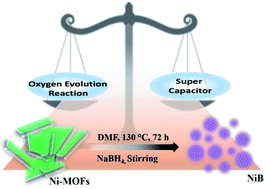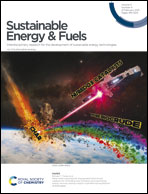Metal–organic framework (MOF)-derived amorphous nickel boride: an electroactive material for electrochemical energy conversion and storage application†
Abstract
The search for an efficient single electrode material having both electrochemical energy conversion and storage activities is a cutting-edge approach for sustainability. In this report, an effective chemical redox approach is presented for the tuning of the crystalline and electronic structures of a metal–organic framework (Ni-MOF) to improve its electrocatalytic and charge storage performance. The single step redox approach transformed the crystalline Ni-MOF to amorphous nickel boride (NiB), showing increased exposed catalytic active centers and accessible surface area thereby improving its electrochemical performance. Interestingly, the NiB efficiently catalyzes the OER, delivering a benchmark current density (10 mA cm−2) at only 240 mV as well as excellent electrocatalytic durability. On the other hand, it shows a higher value of specific capacitance (2580 F g−1) and remarkable energy (72.55 W h kg−1) and power (33.43 kW kg−1) densities with outstanding cycle life (85.45% retention of the initial capacitance after 5000 cycles). In order to validate the practical application of the material, an asymmetric supercapacitor (ASC) was devised in a Swagelok-type electrode with rGO and NiB as the cathode and anode electrode material, respectively. The rGO//NiB ASC device showed a specific capacitance of 83.33 F g−1 (at 0.5 A g−1) with an energy density of 26.04 W h kg−1 at a specific power of 2.08 kW kg−1 with excellent durability (96% specific capacitance retention after 5000 GCD cycles). This synthesis approach realizes the tuning of faradaic redox properties and sheds substantial light on motivating materials researchers to derive MOF-based nanostructures for future energy conversion and storage systems.



 Please wait while we load your content...
Please wait while we load your content...